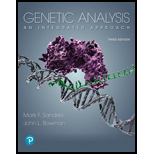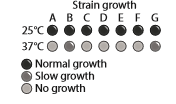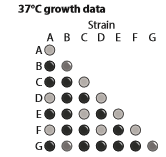
Concept explainers
Yeast are single-celled eukaryotic organisms that grow in culture as either haploids or diploids. Diploid yeast are generated when two haploid strains fuse together. Seven haploid strains of yeast exhibit similar growth habit: At

Describe the nature of the mutation affecting each of these mutant yeast strains. Explain why strains B and G display different growth habit at

How many different genes are mutated among these seven yeast strains? Identify the strains that represent each gene mutation.
Want to see the full answer?
Check out a sample textbook solution
Chapter 4 Solutions
Genetic Analysis: An Integrated Approach Plus Mastering Genetics with Pearson eText -- Access Card Package (3rd Edition) (What's New in Genetics)
- Three different chitin synthase genes control chitin synthesis in S. cerevisiae. Discuss what will happen to the budding yeast if a mutation occurs in each of the genes below: CHSI CHSII CHSIIIarrow_forwardThe intermediates A, B, C, D, E, and F all occur in the same biochemical pathway G is the product of the pathway, and mutations 1 through 7 are all G –, meaning that they cannot produce substance G. The following table shows which intermediates will promote growth in each of the mutants. Arrange the intermediates in order of their occurrence in the pathway at which each mutant strain is blocked. A “+” in the table indicates that the strain will grow if given that substance, an “o” means lack of growth.arrow_forwardYou are interested in studying resistance to heavy metals and have selected the yeast Saccharomyces cerevisea to conduct your studies. You have recovered a deletion mutant that does not tolerate high concentrations of zinc (grows poorly in zinc containing media ) and have designated the mutant pgz-1 (for poor growth in zinc ). (a) What is the advantage to the type of mutant used in this work? What class of mutagen was likely use to generate pgz-1? ( b) Do you expect the PGZ gene to be expressed in your mutant? Explain.arrow_forward
- The figure below shows the life cycle of the fungus Neurospora. The adult stage of the Neurospora is a multicellular haploid. b) Neurospora has an arginine amino acid synthesis pathway shown below. Suppose I take the strain above that only grows with arginine supplements and cross it to a different mutant Neurospora strain that grows with arginine and citrulline supplements but not with ornithine supplements. Assuming gens A, B, and C are unlinked and there is only one mutation per stain: What percentage of the progeny will grow on ornithine? What percentage on citrulline? What percentage on arginine?arrow_forwardYou have identified five genes in S. cerevisiae that are induced when the yeast are grown in a high-salt (NaCl) medium. To study the potential roles of these genes in acclimation to the growth in high-salt conditions, you wish to examine the phenotypes of loss- and gain-of-function alleles of each. How will you do this?arrow_forwardStreptomycin resistance in Chlamydomonas may result from a mutation in either a chloroplast gene or a nuclear gene. What phenotypic results would occur in a cross between a member of an mt+ strain resistant in both genes and a member of a strain sensitive to the antibiotic? What results would occur in the reciprocal cross?arrow_forward
- In E. coli, four Hfr strains donate the following markers,shown in the order donated:Strain 1: M Z X W CStrain 2: L A N C WStrain 3: A L B R UStrain 4: Z M U R BAll these Hfr strains are derived from the same F+ strain.What is the order of these markers on the circularchromosome of the original F+?arrow_forwardDiscuss how ultra violet light works as a mutagen. This could include: What is UV light and the Mutations commonly introduced by UV light? What are the Repair mechanisms in yeast that fix damage caused by UV light? Describe the phenotypes of Saccharomyces Cerevisiae plates, the first plate is the control yeast, while the second plate has been exposed to low UV light, the third plate has been exposed to high UV light. Normal yeast has round smooth white colonies. Are there any signinifcant differences?arrow_forwardThere are five substitution mutations in the dark-colored mutant Mc1r gene. Compare the DNA sequence of the light-colored wild-type Mc1r gene with the DNA sequence of the dark-colored mutant Mc1r gene. Indicate the locations of the five mutations by changing the font color to YELLOW for the five single DNA nucleotides that are mutated in the mutant Mc1r gene table. Using the information in the introduction, determine whether each of these mutations is a silent, missense, or nonsense mutation. Using the mutant Mc1r gene data, fill in the columns (including DNA, mRNA, and amino acid) in gene table 2 that contain a silent mutation with BLUE. Likewise, fill in the columns that contain a missense mutation with RED. Shade any columns that contain nonsense mutations with GREEN. Then Of the five mutations you identified in the mutant Mc1r gene, how many are: substitutions insertions deletions (Enter a number on each line.) 2. Of the five mutations…arrow_forward
- You have isolated 8 mutants in yeast that fail to grow on minimal media plates but do grow when they are supplemented with Arginine. You know that Arginine is synthesized in a biochemical pathway within wild-type yeast, but you do not know how many gene products it takes for the pathway. You have all of the lines as both a and a cells and mate each strain to each other in pairwise crosses and plate them on minimal media to see if they grow. You obtain the following results with (+) representing growth, and (-) indicating no growth: a 1 5 1 a 4 5 6 7 8 How many genes are represented? O 1 3 7 O Cannot tell from the data a + + + + + • + + i 0 +, + + + • + + 7 + + + + + , . + + + + + m + + + + + + + 2 + + + + + i + -I + + . . + + +arrow_forwardYou have a strain of Neurospora that is unable to synthesize histidine and thus requires H in the media in order to grow. You have isolated one revertant colony. Predict the expected proportion of the progeny that would be h+ if you cross the colony with the original mutant colony and the reversion occurred by each of the following mechanisms: Precise change of the mutated base back to its original base. A suppressor gene is mutated on a different chromosome A suppressor gene is mutated on the same chromosome but 10mu distant from the mutated gene. The mutant colony is crossed to a wild-type Neurospora colony and the following data are collected. 95% of all asci scored are h+ but 5% are h-. Which mechanism in part a is consistent with these data? Explain why and what has happened on a molecular level.arrow_forwardAssume that a series of compounds has been discovered in Neurospora. Compounds A–F appear to be intermediates in a biochemical pathway. Conversion of one intermediate to the next is controlled by enzymes that are encoded by genes. Several mutations in these genes have been identified and Neurospora strains 1–4 each contain a single mutation. Strains 1–4 are grown on minimal media supplemented with one of the compounds A–F. The ability of each strain to grow when supplemented with different compounds is shown in the table (+ = growth; o = no growth). Which biochemical pathway fits the data presented? Media Supplement Strain A B C D E F 1 o o o + + + 2 o o o o + + 3 o o o o + o 4 o o + + + + A) A → B → C → D → E → F B) A → B → C → F → D → E C) F → B → C → D → A → E D) A → B → C → D → F → E E) A → B → F → E → C → Darrow_forward
 Human Anatomy & Physiology (11th Edition)BiologyISBN:9780134580999Author:Elaine N. Marieb, Katja N. HoehnPublisher:PEARSON
Human Anatomy & Physiology (11th Edition)BiologyISBN:9780134580999Author:Elaine N. Marieb, Katja N. HoehnPublisher:PEARSON Biology 2eBiologyISBN:9781947172517Author:Matthew Douglas, Jung Choi, Mary Ann ClarkPublisher:OpenStax
Biology 2eBiologyISBN:9781947172517Author:Matthew Douglas, Jung Choi, Mary Ann ClarkPublisher:OpenStax Anatomy & PhysiologyBiologyISBN:9781259398629Author:McKinley, Michael P., O'loughlin, Valerie Dean, Bidle, Theresa StouterPublisher:Mcgraw Hill Education,
Anatomy & PhysiologyBiologyISBN:9781259398629Author:McKinley, Michael P., O'loughlin, Valerie Dean, Bidle, Theresa StouterPublisher:Mcgraw Hill Education, Molecular Biology of the Cell (Sixth Edition)BiologyISBN:9780815344322Author:Bruce Alberts, Alexander D. Johnson, Julian Lewis, David Morgan, Martin Raff, Keith Roberts, Peter WalterPublisher:W. W. Norton & Company
Molecular Biology of the Cell (Sixth Edition)BiologyISBN:9780815344322Author:Bruce Alberts, Alexander D. Johnson, Julian Lewis, David Morgan, Martin Raff, Keith Roberts, Peter WalterPublisher:W. W. Norton & Company Laboratory Manual For Human Anatomy & PhysiologyBiologyISBN:9781260159363Author:Martin, Terry R., Prentice-craver, CynthiaPublisher:McGraw-Hill Publishing Co.
Laboratory Manual For Human Anatomy & PhysiologyBiologyISBN:9781260159363Author:Martin, Terry R., Prentice-craver, CynthiaPublisher:McGraw-Hill Publishing Co. Inquiry Into Life (16th Edition)BiologyISBN:9781260231700Author:Sylvia S. Mader, Michael WindelspechtPublisher:McGraw Hill Education
Inquiry Into Life (16th Edition)BiologyISBN:9781260231700Author:Sylvia S. Mader, Michael WindelspechtPublisher:McGraw Hill Education





